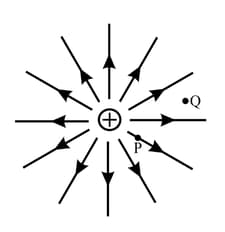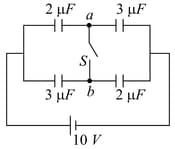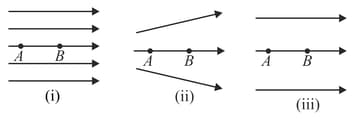Draw electric field lines due to a positive charge and a negative charge.
Important Questions on Fields (HL)
The electric field lines of a positive charge is as shown in figure:

Give the sign of work done by the field in moving a small positive charge from to .
(figures are schematic and not drawn to scale)
(i) A negative test charge experiences a force opposite to the direction of the field.
(ii) The tangent drawn to a line of force represents the direction of electric field.
(iii) The electric field lines never intersect.
(iv) The electric field lines form a closed loop.
Write the properties of electric lines of forces.
The electric field lines on the left have twice the separation on those on the right as shown in figure. If the magnitude of the field at is , what is the force on charge kept at


In the figure is shown a system of four capacitors connected across a battery. The charge that will flow from switch S when it is closed is:

A parallel plate capacitor is made of two circular plates separated by a distance of 5 mm and with a dielectric of dielectric constant 2.2 between them. When the electric field in the dielectric is , the charge density of the positive plate will be close to :

Write the properties of electric lines of force.
Figure shows three arrangements of electric field lines. In each arrangement, a proton is released from rest at point A and then accelerated through point B by the electric field. Points A and B have equal separations in the three arrangements. If and are linear momentum of the proton at point B in the three arrangement respectively, then

A small point mass carrying some positive charge on it, is released from the edge of a table. There is a uniform electric field in this region in the horizontal direction. Which of the following options then correctly describe the trajectory of the mass ? (Curves are drawn schematically and are not to scale)

